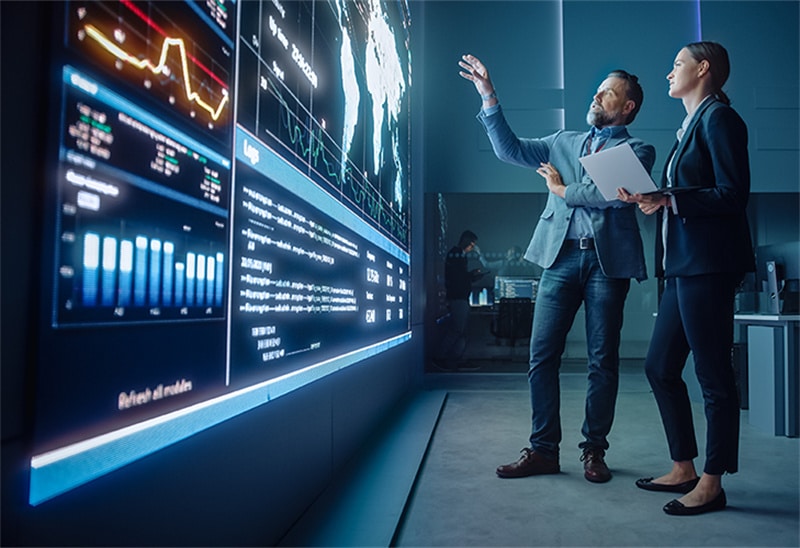
When you’re designing a presentation or conference, it’s integral to think about dynamic display options that can elevate your project. To do this, you might benefit from understanding how AV technology, like video walls, work.
Video walls are at the cutting edge of display technology, and are constantly growing in popularity due to their significant contribution to communication flow, engagement and entertainment.
To help you get the most out of your AV technology, we’ve created this comprehensive guide to all things AV technology. We explain what video walls are, how they work and the types of video walls you can use to elevate your presentation.
What is AV Technology?
Before we get into the specifics of video walls, let’s first explain what AV technology is. AV technology, or audio-visual technology, refers to any products used to capture, process and transmit audio and visual content. This can range from cameras and microphones to the video walls you use to display your footage or images. AV is an incredibly broad term, so it’s important to define the specific product you’re thinking of using, as each piece of AV equipment operates differently.
AV technology is heavily integrated with our everyday lives, as many of us rely on this technology to communicate, consume content, work, and so much more. You can typically categorize AV equipment into four segments. These include:
- Audio devices: Audio equipment usually include microphones, speakers or amps to help your audience engage with your content.
- Visual devices: Visual devices can include projectors, cameras, video wall displays and interactive whiteboards.
- Processing equipment: Processing devices are used to mix, switch and process AV signals to manipulate and create effects.
- Control devices: Controllers involve devices that order the signals to go to certain screens. These can include display controllers for video walls, software and interfaces.
What is a Video Wall?

Now that you understand what AV technology is, it’s time to explore video walls. A video wall is a dynamic, flexible display option that comprises multiple monitors. These monitors work together to display a single content screen, but can also be isolated to display separate snippets of content.
Typically, video walls are displayed in a grid pattern and can be used in settings like transport hubs, control rooms, entertainment settings and sports areas. Many users utilize video walls for the flexibility and ability to display a high volume of content from a single source simultaneously, improving productivity and communication.
Video walls use technology like video wall processors, controllers and matrix switchers to dictate where the content appears on the screens, effects, quality, and so much more!
How Do Video Walls Work?
Let’s explore how video walls work in more depth. Putting it simply, video walls use an array of complex technology to process input signals from both local and remote networks, like CCTV cameras or media players. Here’s a guide to the ins and outs of video wall operations:
Monitors
Video wall monitors are, at face value, the main part of the video wall. Primarily, these are made up of LCD, LED, or OLED screens and, depending on the type, are designed to provide a seamless display that gives the illusion of a single display. The size of your video wall is entirely dependent on your individual project requirements, so if you need a larger display to scale with your business, you’re in luck with a video wall.
Typically, video walls demand high-resolution displays to boost engagement in your audience. Therefore, it’s integral to consider whether your monitor solution facilitates high quality. For example, LED displays typically provide higher quality than LCD monitors, but they tend to be more expensive than LCD monitors initially.
Processors
Video wall processors are the brains behind your video wall project, and are responsible for processing input and output signals that eventually display content on your video wall. Processors can usually manage several input signals and combine them into a single, high-quality visual.
This is then displayed across the video wall regardless of the layout, giving the illusion of a single screen. Processors also go a step further than just processing signals and ensure that the footage remains consistent across all of the display panels. This avoids distortion, which can be very distracting for your audience during presentations.
Video controllers
Another central component of a video wall display is a video controller. Controllers are what allow users like you to dictate where content is placed on a video wall. Putting it simply, these devices offer a single, user-friendly interface that typically enables you to drag and drop content onto specific video walls.
Alongside this, you can improve the quality of your display by changing color contrast and brightness. High-quality video controllers can also enable things like remote access, multiple-user access and other content management features like scheduling and graphics improvement.
Types of Video Walls

One of the best things about video walls is that you can find a video wall that meets your quality and budget criteria. Here’s a brief guide to the types of video walls you can use in your business:
- LCD: LCD video walls are one of the most common types of video walls. The initial affordability of these simplistic panels makes them an attractive option for AV enthusiasts just starting out. However, high energy costs and harsh bezels can both impact budget and engagement levels, so make sure you’re assessing whether LCD screens actually meet your long-term project goals.
- Rear projection: Rear projection video walls is typically a large video wall useful for large-scale presentation. Projectors placed behind a screen create a higher-quality image that mitigates the impact of any borders.
- LED walls: LED video walls are popular video walls renowned for their quality and bright displays. You can typically find these video walls in advertising settings, as they produce eye-catching visuals perfect for marketing usage. One of the main advantages of LED walls includes a longer life span and reduced running costs due to low energy consumption.
Final Thoughts
If you’re thinking of producing a display any time soon, consider using dynamic display options like video walls! These displays can be the perfect weapon when you’re trying to boost engagement in your team, distribute important business announcements, or even for your next company movie night!










